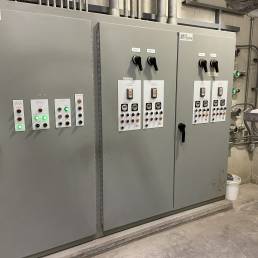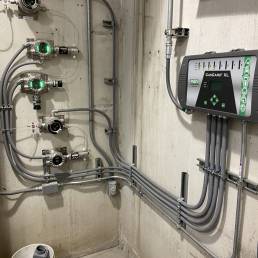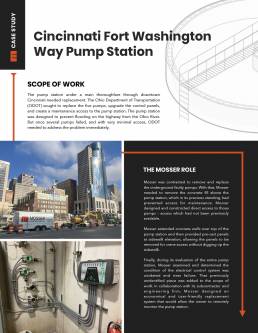Cincinnati Fort Washington Way Pump Station
Cincinnati, Ohio
Scope of Work
The pump station under a main thoroughfare through downtown Cincinnati needed replacement. The Ohio Department of Transportation (ODOT) sought to replace the five pumps, upgrade the control panels, and create a maintenance access to the pump station. The pump station was designed to prevent flooding on the highway from the Ohio River. But once several pumps failed, and with very minimal access, ODOT needed to address the problem immediately.
The Mosser Role
Mosser was contracted to remove and replace the underground faulty pumps. With that, Mosser needed to remove the concrete fill above the pump station, which in its previous standing, had prevented access for maintenance. Mosser designed and constructed direct access to those pumps – access which had not been previously available.
Mosser extended concrete walls over top of the pump station and then provided pre-cast panels at sidewalk elevation, allowing the panels to be removed for crane access without digging up the sidewalk.
Finally, during its evaluation of the entire pump station, Mosser examined and determined the condition of the electrical control system was outdated and near failure. That previously unidentified piece was added to the scope of work. In collaboration with its subcontractor and engineering firm, Mosser designed an economical and user-friendly replacement system that would allow the owner to remotely monitor the pump station.
The Value of Design-Build
Through Design-Build, the most significant cost savings for the project spearheaded by Mosser was reducing the new pump size. The original pumps were 24-inch diameter, but Mosser was able to verify that 20-inch diameter pumps could produce the desired flow characteristics needed for the pump station. Reducing the pump diameter not only saved money for the project, but it also reduced the footprint of the pumps making it easier to remove and reinstall the pumps for the owner.
Another cost-saving measure for the project included using precast panels instead of cast-in-place panels. The cost to form and pour the panels in place over top of a 40-foot deep pump station would have far exceeded the cost of purchasing precast panels.







